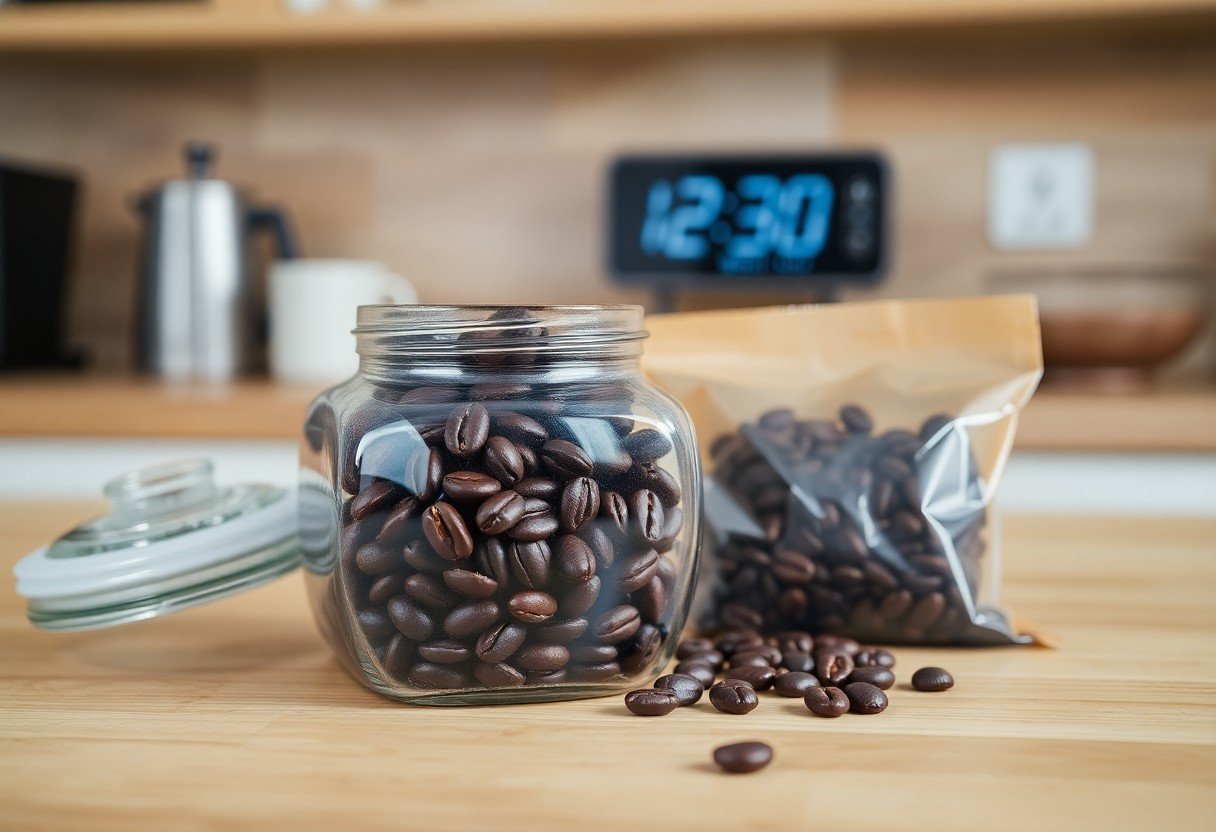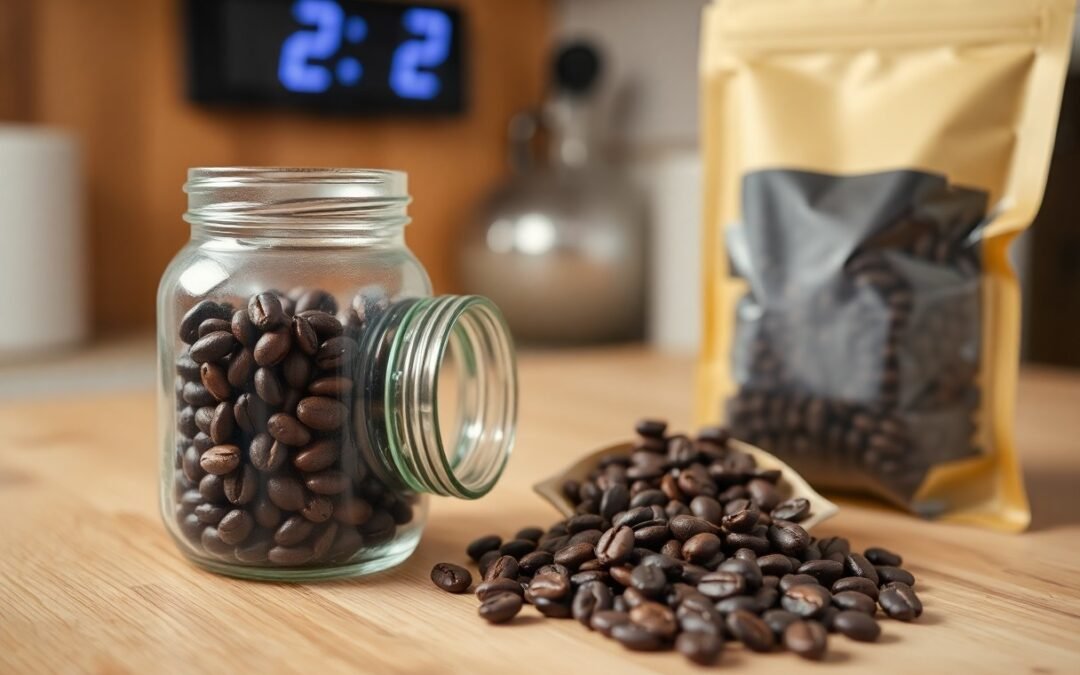Freshness is key to enjoying a perfect cup of coffee, and understanding the lifespan of your coffee beans is fundamental to this pursuit. In this guide, you will learn not only how long your coffee beans stay fresh but also the best practices for storing them properly. By following these tips, you can ensure that every brew you make is rich, aromatic, and full of flavor, allowing you to enjoy your coffee to the fullest.

The Time-Sensitive Nature of Coffee Beans
Coffee beans are inherently time-sensitive, losing their optimal freshness and flavor shortly after roasting. Typically, whole beans reach their peak taste within two to four weeks post-roasting, after which the quality begins to deteriorate. Factors such as exposure to air, moisture, light, and high temperatures can further accelerate this decline, making it imperative to consume your coffee within the right timeframe to truly appreciate its full potential.
How Freshness Affects Flavor and Aroma
The freshness of coffee beans significantly impacts both flavor and aroma. Stale beans, which have been stored improperly or for too long, tend to produce a flat, lifeless taste while fresh beans offer vibrant, complex flavors with enticing aromas. Aroma compounds are volatile and dissipate quickly; thus, the fresher the beans, the more robust the scent and flavor profile of your brew.
The Role of Roast Date and Bean Type
Your choice of roast date and bean type plays a pivotal role in your coffee’s freshness. Beans roasted within the last couple of weeks are preferable, as they retain their natural oils and flavors. Furthermore, the type of bean—whether it’s a light, medium, or dark roast—can affect how quickly the beans go stale. While some beans may maintain their taste longer due to their unique oils and composition, others, particularly lighter roasts, are best consumed soon after roasting for maximum flavor impact.
Different roast levels interact with freshness in distinct ways. Light roasts typically preserve more of the bean’s original flavors and nuances, making them more sensitive to staling. Conversely, dark roasts may mask some freshness loss with their bolder, robust flavors, but they still benefit from being consumed soon after roasting. The bean origin also matters; single-origin beans often deliver unique and delicate taste profiles that can fade quickly. Understanding these factors helps you make informed choices, ensuring you savor every sip of your coffee experience.
Storage Solutions That Preserve Quality
Utilizing appropriate storage solutions significantly impacts the longevity of your coffee beans. By selecting the right containers and controlling environmental factors, you can extend the flavorful experience each cup offers. Airtight, opaque containers shield your beans from light, oxygen, and moisture, all of which can accelerate the deterioration of quality. Simple changes in how you store your beans can transform the way you enjoy your coffee.
The Best Containers for Coffee Beans
The ideal container for your coffee beans is one that is airtight and designed to limit exposure to light and moisture. Options like vacuum-sealed bags or ceramic containers with a rubber seal create an optimal environment for freshness. Avoid glass jars, as they allow light to penetrate, which can lead to flavor degradation. Consider investing in specialized coffee storage containers that have built-in CO2 valves to let gas escape without letting air in.
Temperature and Humidity’s Impact on Freshness
Temperature and humidity play significant roles in maintaining the flavor and freshness of coffee beans. Beans stored in a warm or humid environment tend to lose their flavor more quickly. Ideally, you should keep your coffee in a cool, dry place with a consistent temperature. Fluctuations in heat can affect the oil content of the beans, causing staleness, while high humidity can lead to mold growth.
Environmental Factors Affecting Coffee Storage
| Factor | Impact |
|---|---|
| Temperature | Higher temperatures accelerate oxidation and spoilage. |
| Humidity | Increased moisture can lead to mold and loss of flavor. |
| Light | Exposure to light degrades coffee oils, altering taste profiles. |
For every degree above room temperature, the rate of chemical reactions in coffee beans increases, leading to faster degradation. Similarly, ideal humidity levels should ideally remain below 60% to prevent mold growth. Be mindful of these environmental factors when storing your beans; even minor adjustments can make a significant difference in the freshness of your coffee. A consistent and controlled environment can preserve the quality of your beans, ensuring that each cup maintains its rich flavor profile.
The Life Cycle of Coffee Beans
Once harvested, coffee beans undergo a transformation that begins with processing and ends with roasting before they reach your cup. After picking, the beans are processed to remove their outer fruit layer, launching them into their next phase as they dry, ferment, and mature. Each of these stages impacts the flavor, aroma, and overall quality of the beans, determining how they’ll behave during brewing. Understanding their life cycle allows you to appreciate the journey your coffee takes, making you a more informed consumer and enhancing your overall coffee experience.
Shelf Life: What You Need to Know
Coffee beans can last anywhere from two weeks to a year, depending on how they’re stored. Whole beans generally maintain their freshness longer than pre-ground coffee due to less surface area exposed to oxygen. When kept in a cool, dark place and sealed tightly, you might enjoy the vibrant flavors for several months. However, once opened, the clock starts ticking, and it’s vital to consume the beans within a specific time frame to reap the best taste.
Signs Your Beans Have Gone Stale
Identifying stale coffee beans can be straightforward; key indicators include a loss of aroma, dullness in color, and oily surfaces. Fresh coffee exudes a rich smell, while stale beans tend to have a flat or musty scent. Additionally, they may appear lightly dusted with oil if they’ve aged improperly. Experiencing unusual flavors during brewing can also signal that your beans have surpassed their prime.
Stale coffee beans lose their distinctive flavor profiles, often leading to a bitter and unimpressive cup. If you notice a lack of the usual rich aroma or a reduction in the coffee’s characteristic taste, it’s likely that your beans have gone stale. Proper storage can mitigate this, but if you’ve opened a bag and several weeks have passed, consider doing a taste test. An off-flavor may mean it’s time to replace your coffee beans for a fresher brew experience.
Creative Ways to Extend Freshness
Beyond standard storage methods, exploring creative techniques can significantly extend the freshness of your coffee beans. Implementing strategies such as freezing or vacuum sealing can keep your coffee tasting vibrant for longer. Alternatively, if you find yourself with stale coffee, consider innovative ways to repurpose it. These approaches not only reduce waste but can also add a unique twist to your culinary creations.
Freezing and Vacuum Sealing Techniques
Freezing your coffee beans in airtight containers prevents air exposure and preserves their flavor. Vacuum sealing is another effective method that removes air and locks in freshness. Both techniques can keep your coffee beans fresh for several months, allowing you to enjoy a flavorful cup even with prolonged storage. Aim to portion your beans, so you only defrost what you need, maintaining quality each time you brew.
Innovative Ways to Use Stale Coffee
Stale coffee doesn’t have to end up in the trash. Instead, you can transform it into a delightful ingredient for various recipes or home remedies. Consider using stale coffee grounds as a natural exfoliant in your skincare routine or as a deodorizer for your refrigerator. You might even add them to savory dishes or baked goods for an unexpected punch of flavor, showcasing the versatility of coffee beyond your morning brew.
Turning stale coffee into a flavorful ingredient opens a world of possibilities. You can use coffee grounds in recipes like coffee-infused chocolate cake or even as a spice rub for meats, tapping into the deep flavors they provide. Additionally, stir stale coffee into smoothies for an energizing boost or brew it into a rich sauce for desserts. These innovative approaches to stale coffee not only minimize waste but can elevate your culinary experiences to new heights.
Summing up
On the whole, understanding how long your coffee beans last and the best ways to store them can significantly enhance your coffee experience. By keeping your beans in an airtight container, away from light, heat, and moisture, you can preserve their freshness for weeks. Aim to use your beans within a month for optimum flavor, and consider purchasing smaller quantities to keep them fresh. By applying these storage tips, you can enjoy your coffee at its best, every time you brew.
FAQ
Q: How long do coffee beans typically last before they go stale?
A: Coffee beans can maintain their freshness for about 2 to 4 weeks after roasting, depending on the type and quality of the beans. Whole beans generally retain their flavor longer than ground coffee. If stored properly in an airtight container in a cool, dark place, whole beans can last up to 6 months, although their peak flavor is often experienced within the first month after roasting.
Q: What is the best way to store coffee beans to maintain their freshness?
A: To keep coffee beans fresh, store them in an airtight container to limit exposure to air, light, and moisture. Ideally, use a opaque, airtight jar made of glass, ceramic, or non-reactive metal. It is also recommended to keep them in a cool, dry location away from direct sunlight, such as a pantry. Avoid refrigeration or freezing unless absolutely necessary, as moisture from the environment can negatively affect the beans.
Q: Is it better to buy whole beans or pre-ground coffee for freshness?
A: Whole beans are generally preferable when it comes to preserving freshness. Grinding coffee increases its surface area, which allows for quicker oxidation and flavor loss. Buying whole beans and grinding them just before brewing helps to capture the coffee’s full flavor and aroma, ensuring a more enjoyable coffee experience. If you opt for pre-ground coffee for convenience, be aware that it may lose its freshness more rapidly than whole beans.

